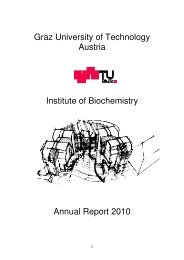Staff Members of the Institute of Biochemistry, TU - Institut für ...
Staff Members of the Institute of Biochemistry, TU - Institut für ...
Staff Members of the Institute of Biochemistry, TU - Institut für ...
You also want an ePaper? Increase the reach of your titles
YUMPU automatically turns print PDFs into web optimized ePapers that Google loves.
Brief History <strong>of</strong> <strong>the</strong> <strong><strong>Institut</strong>e</strong> <strong>of</strong> <strong>Biochemistry</strong><br />
The <strong><strong>Institut</strong>e</strong> <strong>of</strong> <strong>Biochemistry</strong> and Food Chemistry was born out <strong>of</strong> <strong>the</strong> division <strong>of</strong> <strong>the</strong> <strong><strong>Institut</strong>e</strong><br />
<strong>of</strong> Biochemical Technology, Food Chemistry and Microchemistry <strong>of</strong> <strong>the</strong> former School <strong>of</strong><br />
Technology Graz. Toge<strong>the</strong>r with all <strong>the</strong> o<strong>the</strong>r chemistry institutes, it was located in <strong>the</strong> old<br />
Chemistry Building on Baron Mandell's ground, corner Technikerstrasse-Mandellstrasse.<br />
1929 The <strong><strong>Institut</strong>e</strong> <strong>of</strong> Technical <strong>Biochemistry</strong> and Microbiology moved to <strong>the</strong> building <strong>of</strong><br />
<strong>the</strong> Fürstlich-Dietrichstein-Stiftung, Schlögelgasse 9, in which all <strong>the</strong> biosciences were<br />
<strong>the</strong>n concentrated.<br />
1945 Georg GORBACH - initially in <strong>the</strong> rank <strong>of</strong> a docent and soon <strong>the</strong>reafter as a.o.<br />
Pr<strong>of</strong>essor - took over to lead <strong>the</strong> institute. The institute was renamed <strong><strong>Institut</strong>e</strong> <strong>of</strong><br />
Biochemical Technology and Food Chemistry.<br />
1948 G. GORBACH was nominated full pr<strong>of</strong>essor and head <strong>of</strong> <strong>the</strong> institute. In succession <strong>of</strong><br />
<strong>the</strong> famous Graz School <strong>of</strong> Microchemistry founded by PREGL and EMICH, Pr<strong>of</strong>.<br />
GORBACH was one <strong>of</strong> <strong>the</strong> most prominent and active leaders in <strong>the</strong> fields <strong>of</strong><br />
microchemistry, microbiology and nutritional sciences. After World War II, questions<br />
<strong>of</strong> water quality and waste water disposal became urgent; hence, <strong>the</strong> group <strong>of</strong> Pr<strong>of</strong>. K.<br />
S<strong>TU</strong>NDL, which at that time was part <strong>of</strong> <strong>the</strong> institute, was gaining importance. In<br />
addition, a division to fight dry-rot supervised by Dr. KUNZE and after his demise by<br />
H. SALOMON, was also affiliated with <strong>the</strong> institute.<br />
1955 In honour <strong>of</strong> <strong>the</strong> founder <strong>of</strong> microchemistry and former pr<strong>of</strong>essor at <strong>the</strong> Graz<br />
University <strong>of</strong> Technology, <strong>the</strong> extended laboratory was called EMICH-Laboratories.<br />
At <strong>the</strong> same time, <strong>the</strong> institute was renamed <strong><strong>Institut</strong>e</strong> <strong>of</strong> Biochemical Technology,<br />
Food Chemistry and Microchemistry.<br />
Lectures and laboratory courses were held in biochemistry, biochemical technology, food<br />
chemistry and food technology, technical microscopy and microchemistry. In addition, <strong>the</strong><br />
institute covered technical microbiology toge<strong>the</strong>r with biological and bacteriological analysis<br />
- with <strong>the</strong> exception <strong>of</strong> pathogenic microorganisms - and a lecture in organic raw materials<br />
sciences.<br />
1970 After <strong>the</strong> decease <strong>of</strong> Pr<strong>of</strong>. GORBACH, Pr<strong>of</strong>. GRUBITSCH was appointed head <strong>of</strong> <strong>the</strong><br />
institute. Towards <strong>the</strong> end <strong>of</strong> <strong>the</strong> sixties, <strong>the</strong> division for water and waste water<br />
disposal headed by Pr<strong>of</strong>. S<strong>TU</strong>NDL was drawn out <strong>of</strong> <strong>the</strong> institute and established as<br />
an independent institute. Pr<strong>of</strong>. SPITZY was nominated pr<strong>of</strong>essor <strong>of</strong> general chemistry,<br />
micro- and radiochemistry. This division was also drawn out <strong>of</strong> <strong>the</strong> mo<strong>the</strong>r institute<br />
and at <strong>the</strong> end <strong>of</strong> <strong>the</strong> sixties moved to a new building.<br />
1973 Division <strong>of</strong> <strong>the</strong> <strong><strong>Institut</strong>e</strong> for Biochemical Technology, Food Technology and<br />
Microchemistry took place. At first, biochemical technology toge<strong>the</strong>r with food<br />
technology formed a new institute now called <strong><strong>Institut</strong>e</strong> <strong>of</strong> Biotechnology and Food<br />
Chemistry headed by Pr<strong>of</strong>. LAFFERTY.<br />
1973 Dr. F. PALTAUF, docent at <strong>the</strong> Karl-Franzens-University Graz, was appointed<br />
pr<strong>of</strong>essor and head <strong>of</strong> <strong>the</strong> newly established <strong><strong>Institut</strong>e</strong> <strong>of</strong> <strong>Biochemistry</strong>. The interest <strong>of</strong><br />
Pr<strong>of</strong>. PALTAUF in studying biological membranes and lipids laid <strong>the</strong> foundation for<br />
2














